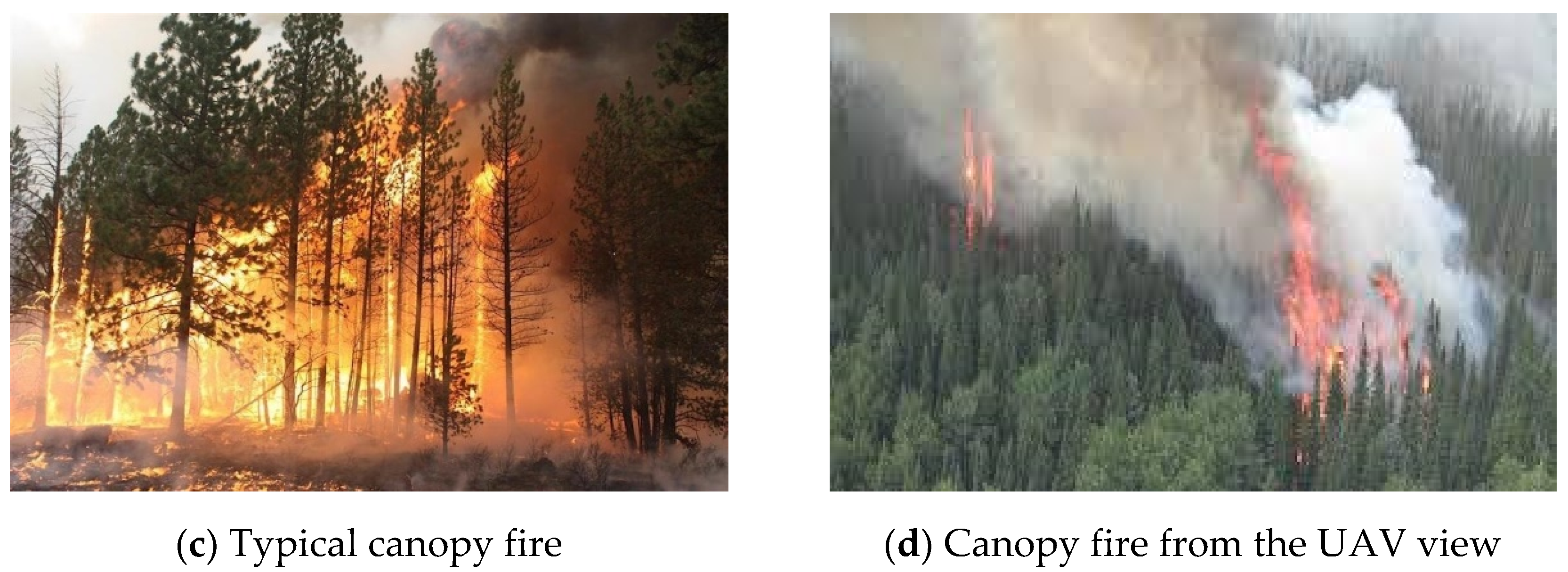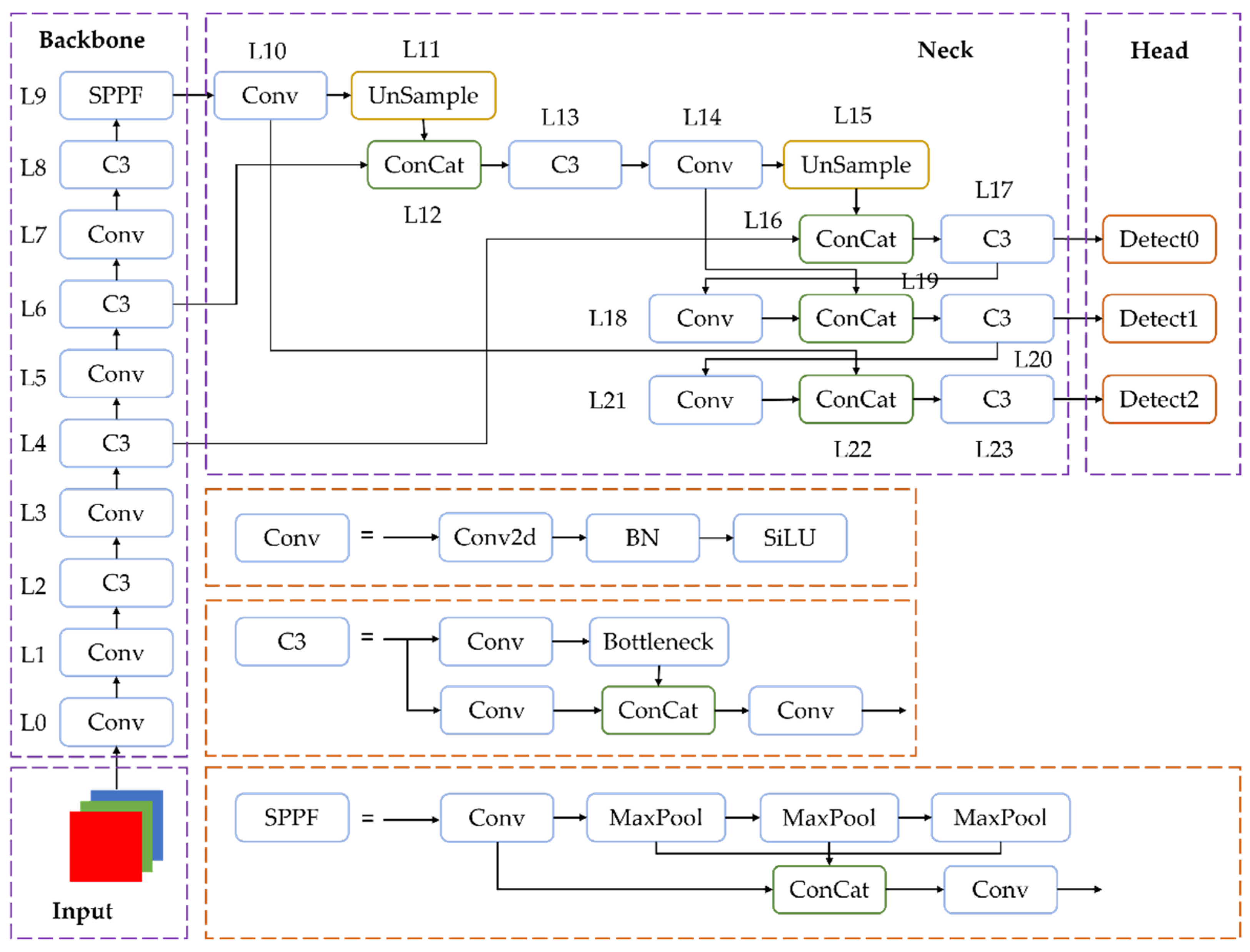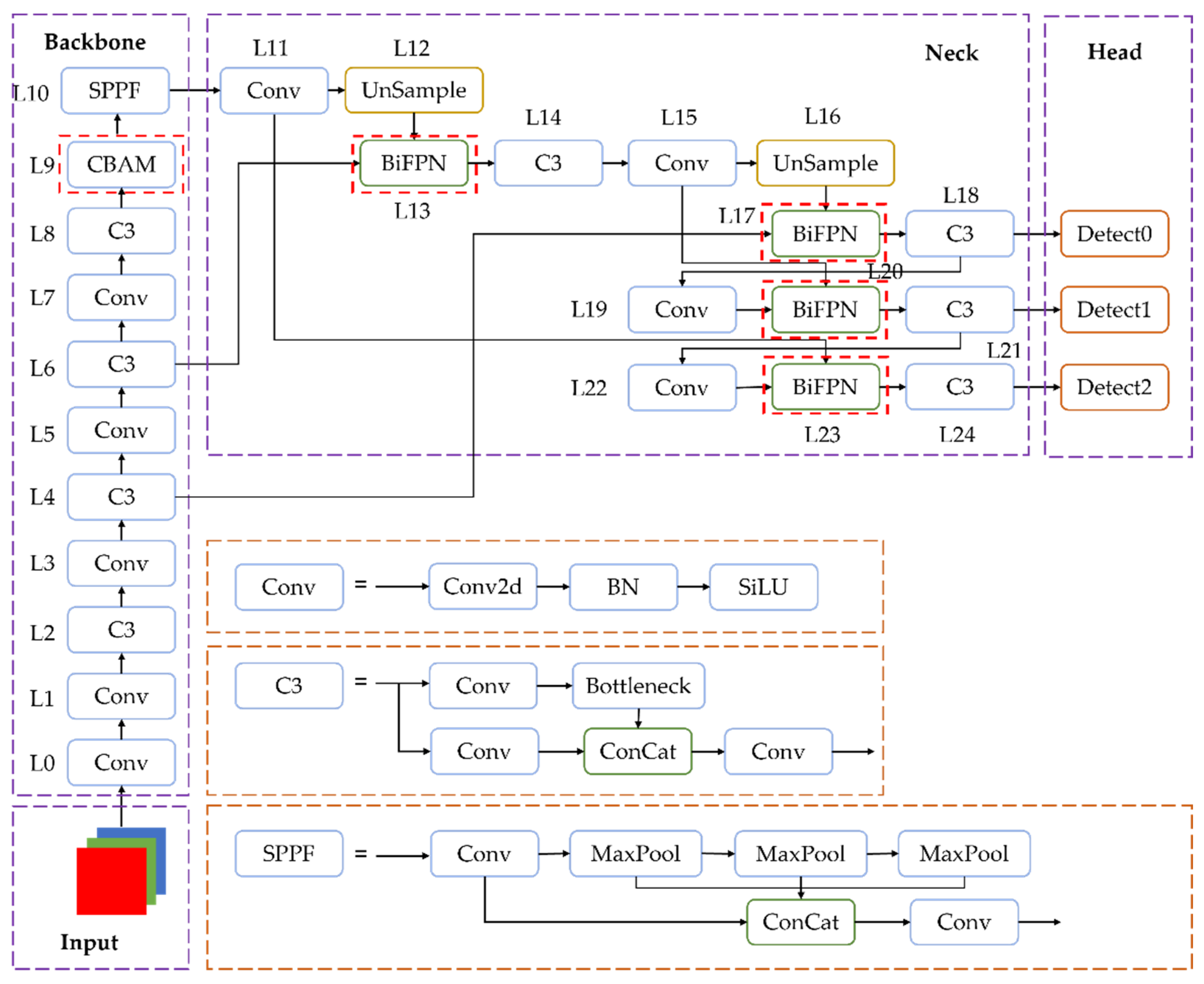FCDM: An Improved Forest Fire Classification and Detection Model Based on YOLOv5
Abstract
1. Introduction
2. Materials and Methods
2.1. Dataset
2.2. YOLOv5
2.3. SIoU Loss
2.4. CBAM
2.5. BiFPN
2.6. Improved Forest Fire Classification and Detection Model FCDM
3. Results
3.1. Training
3.2. Model Evaluation
3.3. Detect Performance and Analysis
4. Discussion
5. Conclusions
Author Contributions
Funding
Data Availability Statement
Conflicts of Interest
References
- Gong, L. Effect and Function of Forest Fire on Forest. For. Sci. Technol. Inf. 2011, 3, 46–48. [Google Scholar]
- Tang, S.; Li, H.; Shan, Y.; Xiao, Y.; Yi, S. Characteristics and Control of Underground Forest Fire. World For. Res. 2019, 32, 42–48. [Google Scholar]
- Zhu, M.; Feng, Z.K.; Lin, H.U. Improvement of forest surface fire spread models. J. Beijing For. Univ. 2005, S2, 145–148. [Google Scholar]
- Hao, Q.; Huang, X.; Luo, C.; Yang, Y. Realization and Application of Mountain Fire Infrared Radar Alarming System of Transmission Line. Guangxi Electr. Power 2015, 38, 67–71. [Google Scholar]
- Yuan, C.; Liu, Z.; Zhang, Y. Vision-based Forest Fire Detection in Aerial Images for Firefighting Using UAVs. In Proceedings of the International Conference on Unmanned Aircraft Systems, Arlington, VA, USA, 7–10 June 2016. [Google Scholar]
- Prosekov, A.Y.; Rada, A.O.; Kuznetsov, A.D.; Timofeev, A.E.; Osintseva, M.A. Environmental monitoring of endogenous fires based on thermal imaging and 3D mapping from an unmanned aerial vehicle. In IOP Conference Series: Earth and Environmental Science; IOP Publishing: Bristol, UK, 2022; Volume 981, p. 042016. [Google Scholar]
- Muid, A.; Kane, H.; Sarasawita IK, A.; Evita, M.; Aminah, N.S.; Budiman, M.; Djamal, M. Potential of UAV Application for Forest Fire Detection; IOP Publishing Ltd.: Bristol, UK, 2022. [Google Scholar]
- Hua, L.; Shao, G. The progress of operational forest fire monitoring with infrared remote sensing. J. For. Res. 2017, 28, 215–229. [Google Scholar] [CrossRef]
- Long, X.M.; Zhao, C.M.; Ding, K.; Yang, K.Y.; Zhou, R.L. A Method of Improving Geometric Accuracy of Forest Fire Monitoring by Satellite Imagery Based on Terrain Features. Remote Sens. Inf. 2016, 31, 89–94. [Google Scholar]
- Ganesan, P.; Sathish, B.S.; Sajiv, G. A comparative approach of identification and segmentation of forest fire region in high resolution satellite images. In Proceedings of the 2016 World Conference on Futuristic Trends in Research and Innovation for Social Welfare (Startup Conclave), Coimbatore, India, 29 February–1 March 2016. [Google Scholar]
- Lin, J.; Lin, H.; Wang, F. STPM_SAHI: A Small-Target Forest Fire Detection Model Based on Swin Transformer and Slicing Aided Hyper Inference. Forests 2022, 13, 1603. [Google Scholar] [CrossRef]
- Xue, Z.; Lin, H.; Wang, F. A Small Target Forest Fire Detection Model Based on YOLOv5 Improvement. Forests 2022, 13, 1332. [Google Scholar] [CrossRef]
- Qian, J.; Lin, H. A Forest Fire Identification System Based on Weighted Fusion Algorithm. Forests 2022, 13, 1301. [Google Scholar] [CrossRef]
- Yuan, C.; Liu, Z.; Zhang, Y. UAV-based forest fire detection and tracking using image processing techniques. In Proceedings of the 2015 International Conference on Unmanned Aircraft Systems (ICUAS), Denver, CO, USA, 9–12 June 2015; pp. 639–643. [Google Scholar]
- Han, X.F.; Jin, J.S.; Wang, M.J.; Jiang, W.; Gao, L.; Xiao, L.P. Video fire detection based on Gaussian Mixture Model and multi-color features. Signal Image Video Process. 2017, 11, 1419–1425. [Google Scholar] [CrossRef]
- Emmy Prema, C.; Vinsley, S.S.; Suresh, S. Efficient flame detection based on static and dynamic texture analysis in forest fire detection. Fire Technol. 2018, 54, 255–288. [Google Scholar] [CrossRef]
- Mahmoud, M.A.I.; Ren, H. Forest fire detection and identification using image processing and SVM. J. Inf. Process. Syst. 2019, 15, 159–168. [Google Scholar]
- Lin, H.; Tang, C. Analysis and Optimization of Urban Public Transport Lines Based on Multiobjective Adaptive Particle Swarm Optimization. IEEE Trans. Intell. Transp. Syst. 2021, 23, 16786–16798. [Google Scholar] [CrossRef]
- Chen, Y.; Zhang, Y.; Xin, J.; Wang, G.; Mu, L.; Yi, Y.; Liu, H.; Liu, D. UAV image-based forest fire detection approach using convolutional neural network. In Proceedings of the 2019 14th IEEE Conference on Industrial Electronics and Applications (ICIEA), Xi’an, China, 19–21 June 2019; pp. 2118–2123. [Google Scholar]
- Barmpoutis, P.; Dimitropoulos, K.; Kaza, K.; Grammalidis, N. Fire detection from images using faster R-CNN and multidimensional texture analysis. In Proceedings of the 2019 IEEE International Conference on Acoustics, Speech and Signal Processing (ICASSP-2019), Brighton, UK, 12–17 May 2019; pp. 8301–8305. [Google Scholar]
- Li, P.; Zhao, W. Image fire detection algorithms based on convolutional neural networks. Case Stud. Therm. Eng. 2020, 19, 100625. [Google Scholar] [CrossRef]
- Majid, S.; Alenezi, F.; Masood, S.; Ahmad, M.; Gündüz, E.S.; Polat, K. Attention based CNN model for fire detection and localization in real-world images. Expert Syst. Appl. 2022, 189, 116114. [Google Scholar] [CrossRef]
- Barisic, A.; Car, M.; Bogdan, S. Vision-based system for a real-time detection and following of UAV. In Proceedings of the 2019 Workshop on Research, Education and Development of Unmanned Aerial Systems (RED UAS), Cranfield, UK, 25–27 November 2019; pp. 156–159. [Google Scholar]
- Ultralytics-Yolov5. Available online: https://github.com/ultrelytics/yolov5 (accessed on 5 June 2022).
- Zheng, Z.; Wang, P.; Liu, W.; Li, J.; Ye, R.; Ren, D. Distance-IoU loss: Faster and better learning for bounding box regression. In Proceedings of the AAAI Conference on Artificial Intelligence, New York, NY, USA, 7–12 February 2020; Volume 34, pp. 12993–13000. [Google Scholar]
- Gevorgyan, Z. SIoU Loss: More Powerful Learning for Bounding Box Regression. arXiv 2022, arXiv:2205.12740. [Google Scholar]
- Woo, S.; Park, J.; Lee, J.Y.; Kweon, I.S. Cbam: Convolutional block attention module. In Proceedings of the European Conference on Computer Vision (ECCV), Munich, Germany, 8–14 September 2018; pp. 3–19. [Google Scholar]
- Liu, S.; Qi, L.; Qin, H.; Shi, J.; Jia, J. Path aggregation network for instance segmentation. In Proceedings of the IEEE Conference on Computer Vision and Pattern Recognition, Salt Lake City, UT, USA, 18–22 June 2018; pp. 8759–8768. [Google Scholar]
- Tan, M.; Pang, R.; Le, Q.V. Efficientdet: Scalable and efficient object detection. In Proceedings of the IEEE/CVF Conference on Computer Vision and Pattern Recognition, San Francisco, CA, USA, 13–18 June 2020; pp. 10781–10790. [Google Scholar]
- Lin, T.Y.; Dollár, P.; Girshick, R.; He, K.; Hariharan, B.; Belongie, S. Feature pyramid networks for object detection. In Proceedings of the IEEE Conference on Computer Vision and Pattern Recognition, Honolulu, HI, USA, 21–26 July 2017; pp. 2117–2125. [Google Scholar]
- Lin, H.; Tang, C. Intelligent Bus Operation Optimization by Integrating Cases and Data Driven Based on Business Chain and Enhanced Quantum Genetic Algorithm. IEEE Trans. Intell. Transp. Syst. 2021, 23, 9869–9882. [Google Scholar] [CrossRef]
- Lin, H.; Han, Y.; Cai, W.; Jin, B. Traffic Signal Optimization Based on Fuzzy Control and Differential Evolution Algorithm. IEEE Trans. Intell. Transp. Syst. 2022, 1–12. [Google Scholar] [CrossRef]
- Wang, C.Y.; Liao HY, M.; Wu, Y.H.; Chen, P.Y.; Hsieh, J.W.; Yeh, I.H. CSPNet: A new backbone that can enhance learning capability of CNN. In Proceedings of the IEEE/CVF Conference on Computer Vision and Pattern Recognition Workshops, Seattle, WA, USA, 14–19 June 2020; pp. 390–391. [Google Scholar]
- He, K.; Zhang, X.; Ren, S.; Sun, J. Spatial pyramid pooling in deep convolutional networks for visual recognition. IEEE Trans. Pattern Anal. Mach. Intell. 2015, 37, 1904–1916. [Google Scholar] [CrossRef]
- Lin, T.Y.; Maire, M.; Belongie, S.; Hays, J.; Perona, P.; Ramanan, D.; Dollár, P.; Zitnick, C.L. Microsoft coco: Common objects in context. In Proceedings of the European Conference on Computer Vision, Zurich, Switzerland, 6–12 September 2014; pp. 740–755. [Google Scholar]
- Hu, J.; Shen, L.; Sun, G. Squeeze-and-excitation networks. In Proceedings of the IEEE Conference on Computer Vision and Pattern Recognition, Salt Lake City, UT, USA, 18–22 June 2018; pp. 7132–7141. [Google Scholar]
- Liu, Y.; Shao, Z.; Hoffmann, N. Global Attention Mechanism: Retain Information to Enhance Channel-Spatial Interactions. arXiv 2021, arXiv:2112.05561. [Google Scholar]
- Abatzoglou, J.T.; Battisti, D.S.; Williams, A.P. Projected increases in western US forest fire despite growing fuel constraints. Commun. Earth Environ. 2021, 2, 1–8. [Google Scholar] [CrossRef]













| Experimental Environment | Details |
|---|---|
| Programming language | Python 3.9 |
| Operating system | Windows 11 |
| Deep learning framework | Pytorch 1.12.1 |
| GPU | NVIDIA GeForce RTX 3060 |
| Training Parameters | Details |
|---|---|
| Epochs | 200 |
| batch-size | 8 |
| Img-size | 640 × 640 |
| Initial learning rate | 0.01 |
| Optimization algorithm | SGD |
| Dataset | Train | Val | Test |
|---|---|---|---|
| forest fire dataset | 441 | 49 | 54 |
| surface fire | 242 | 27 | 31 |
| canopy fire | 197 | 22 | 25 |
| Model | Forest Fire Detection (mAP@0.5) | Surface Fire Detection (mAP@0.5) | Canopy Fire Detection (mAP@0.5) | FPS | Time (ms) |
|---|---|---|---|---|---|
| YOLOv5s | 0.830 | 0.791 | 0.868 | 58 | 17.2 |
| YOLOv5s + Alpha-IoU | 0.802 | 0.761 | 0.844 | 62 | 16.1 |
| YOLOv5s + SIoU | 0.851 | 0.805 | 0.896 | 63 | 15.9 |
| YOLOv5s + SIoU + SE | 0.851 | 0.791 | 0.901 | 63 | 15.9 |
| YOLOv5s + SIoU + GAM | 0.860 | 0.803 | 0.907 | 28 | 35.7 |
| YOLOv5s + SIoU + CBAM | 0.864 | 0.828 | 0.899 | 61 | 16.4 |
| YOLOv5s + SIoU + GAM + BiFPN | 0.861 | 0.793 | 0.908 | 56 | 17.9 |
| YOLOv5s + SIoU + CBAM + BiFPN (FCDM, ours) | 0.869 | 0.831 | 0.906 | 64 | 15.6 |
Publisher’s Note: MDPI stays neutral with regard to jurisdictional claims in published maps and institutional affiliations. |
© 2022 by the authors. Licensee MDPI, Basel, Switzerland. This article is an open access article distributed under the terms and conditions of the Creative Commons Attribution (CC BY) license (https://creativecommons.org/licenses/by/4.0/).
Share and Cite
Xue, Q.; Lin, H.; Wang, F. FCDM: An Improved Forest Fire Classification and Detection Model Based on YOLOv5. Forests 2022, 13, 2129. https://doi.org/10.3390/f13122129
Xue Q, Lin H, Wang F. FCDM: An Improved Forest Fire Classification and Detection Model Based on YOLOv5. Forests. 2022; 13(12):2129. https://doi.org/10.3390/f13122129
Chicago/Turabian StyleXue, Qilin, Haifeng Lin, and Fang Wang. 2022. "FCDM: An Improved Forest Fire Classification and Detection Model Based on YOLOv5" Forests 13, no. 12: 2129. https://doi.org/10.3390/f13122129
APA StyleXue, Q., Lin, H., & Wang, F. (2022). FCDM: An Improved Forest Fire Classification and Detection Model Based on YOLOv5. Forests, 13(12), 2129. https://doi.org/10.3390/f13122129






